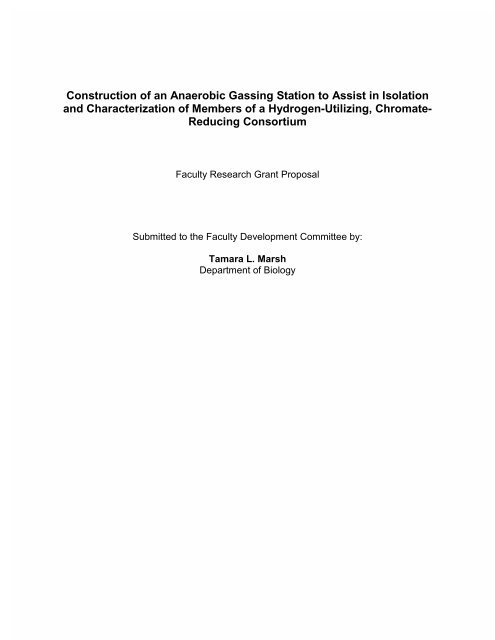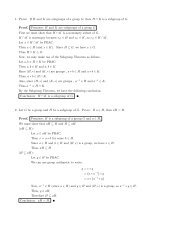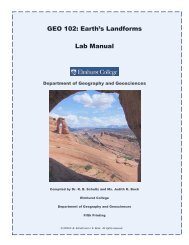Construction of an Anaerobic Gassing Station to ... - Elmhurst College
Construction of an Anaerobic Gassing Station to ... - Elmhurst College
Construction of an Anaerobic Gassing Station to ... - Elmhurst College
Create successful ePaper yourself
Turn your PDF publications into a flip-book with our unique Google optimized e-Paper software.
<strong>Construction</strong> <strong>of</strong> <strong>an</strong> <strong>Anaerobic</strong> <strong>Gassing</strong> <strong>Station</strong> <strong>to</strong> Assist in Isolation<br />
<strong>an</strong>d Characterization <strong>of</strong> Members <strong>of</strong> a Hydrogen-Utilizing, Chromate-<br />
Reducing Consortium<br />
Faculty Research Gr<strong>an</strong>t Proposal<br />
Submitted <strong>to</strong> the Faculty Development Committee by:<br />
Tamara L. Marsh<br />
Department <strong>of</strong> Biology
I. Project Summary<br />
Marsh, T. L. 2 <strong>of</strong> 7<br />
Chromium is a unique element, functioning as both <strong>an</strong> essential micronutrient <strong>an</strong>d a<br />
carcinogen depending on the valence state. Hexavalent chromium [Cr(VI)] is<br />
carcinogenic, mutagenic, <strong>an</strong>d readily soluble in water, allowing it <strong>to</strong> move easily in<br />
aquatic environments. M<strong>an</strong>y industrial processes are known <strong>to</strong> generate large<br />
qu<strong>an</strong>tities <strong>of</strong> Cr(VI)-laden wastewater which must be treated before release. On the<br />
other h<strong>an</strong>d, trivalent chromium is necessary for functioning <strong>of</strong> <strong>an</strong>imal cells, 100-fold<br />
less <strong>to</strong>xic th<strong>an</strong> the hexavalent form, <strong>an</strong>d is nearly insoluble in water. Thus,<br />
conversion <strong>of</strong> the hexavalent form <strong>to</strong> the trivalent is a satisfac<strong>to</strong>ry treatment strategy.<br />
Current treatments bring about a chemical reduction but are costly <strong>an</strong>d create other<br />
forms <strong>of</strong> waste. Finding a biological system <strong>to</strong> catalyze hexavalent chromium<br />
reduction presents <strong>an</strong> economical alternative <strong>to</strong> current regimes. This requires a<br />
deeper knowledge <strong>of</strong> the biochemistry <strong>of</strong> the org<strong>an</strong>isms capable <strong>of</strong> these reactions,<br />
a knowledge which is currently unavailable.<br />
Org<strong>an</strong>isms <strong>of</strong> import<strong>an</strong>ce in contaminated ecosystems would likely be categorized<br />
as strictly <strong>an</strong>aerobic, growing only in the absence <strong>of</strong> molecular oxygen. Cultivation<br />
<strong>of</strong> such org<strong>an</strong>isms would require the use <strong>of</strong> <strong>an</strong> <strong>an</strong>aerobic gassing station <strong>to</strong> remove<br />
all oxygen molecules from gases <strong>an</strong>d materials which might come in<strong>to</strong> contact with<br />
microbial cultures. After construction <strong>of</strong> the gassing station is completed it will be<br />
essential in techniques used <strong>to</strong> study <strong>an</strong>aerobic org<strong>an</strong>isms such as Cr(VI)-reducing<br />
or meth<strong>an</strong>ogenic. This funding will allow the purchase <strong>of</strong> parts <strong>an</strong>d equipment <strong>to</strong><br />
construct such a system making it possible <strong>to</strong> begin a research program in<br />
<strong>an</strong>aerobic microbiology at <strong>Elmhurst</strong> <strong>College</strong>.<br />
II. Narrative<br />
1. Current Situation<br />
Industrial practices including electroplating, leather t<strong>an</strong>ning, pigment m<strong>an</strong>ufacture,<br />
corrosion inhibition, <strong>an</strong>d fungicide production generate large qu<strong>an</strong>tities <strong>of</strong> chromiumladen<br />
wastewater, which must be treated before discharge. About 170,000 <strong>to</strong>ns <strong>of</strong><br />
chromium wastes are released in<strong>to</strong> the environment <strong>an</strong>nually. The widespread use<br />
<strong>of</strong> chromium as well as the improper disposal <strong>of</strong> chromium-laden wastes has led <strong>to</strong><br />
areas <strong>of</strong> serious environmental contamination. The prevalence <strong>of</strong> chromium<br />
contamination has resulted in the classification <strong>of</strong> chromium as one <strong>of</strong> the seventeen<br />
most import<strong>an</strong>t environmental <strong>to</strong>xic<strong>an</strong>ts by the U.S. Environmental Protection<br />
Agency.<br />
Chromium exists in oxidation states r<strong>an</strong>ging from 0 <strong>to</strong> +6, although, only two states,<br />
Cr(III) <strong>an</strong>d Cr(VI), are commonly observed in environmental samples. The valence<br />
state <strong>an</strong>d relative solubility <strong>of</strong> chromium are dependent on environmental conditions<br />
(pH, temperature, redox potential) <strong>an</strong>d the presence <strong>of</strong> other org<strong>an</strong>ic <strong>an</strong>d inorg<strong>an</strong>ic<br />
molecules. Trivalent chromium, or Cr(III), <strong>an</strong> essential trace nutrient in the hum<strong>an</strong><br />
diet, has relatively low <strong>to</strong>xicity <strong>an</strong>d is nearly insoluble at neutral pH, <strong>an</strong>d thus, nearly<br />
immobile in the environment. Conversely, hexavalent chromium, or Cr(VI) is acutely
Marsh, T. L. 3 <strong>of</strong> 7<br />
<strong>to</strong>xic, mutagenic, tera<strong>to</strong>genic, <strong>an</strong>d carcinogenic. In addition, Cr(VI) is highly mobile<br />
in the environment, mainly due <strong>to</strong> its soluble nature.<br />
Common treatment technologies for removal <strong>of</strong> chromium from industrial waste<br />
include ion exch<strong>an</strong>ge, electrodepositing, <strong>an</strong>d chemical reduction with iron <strong>an</strong>d sulfurcontaining<br />
solutions (FeSO4, Na2SO3, NaHSO3, <strong>an</strong>d Na2S2O5) followed by<br />
precipitation. These methods, while effective, c<strong>an</strong> be quite costly, requiring high<br />
energy input or large qu<strong>an</strong>tities <strong>of</strong> chemical reagents, <strong>an</strong>d c<strong>an</strong> create other forms <strong>of</strong><br />
waste with unique environmental concerns. The biological reduction <strong>of</strong> Cr(VI) <strong>to</strong><br />
Cr(III) may provide a less costly approach <strong>to</strong> soil <strong>an</strong>d aquifer remediation.<br />
Although m<strong>an</strong>y bacterial strains have been shown <strong>to</strong> mediate reduction <strong>of</strong> Cr(VI) <strong>to</strong><br />
Cr(III), few studies have examined the in situ potential <strong>of</strong> microbial Cr(VI) reduction<br />
in aquifers. The stimulation <strong>of</strong> existing microbial populations may result in microbial<br />
chromium reduction, potentially reducing the migration <strong>of</strong> Cr(VI) in aquifers.<br />
Thermodynamic predictions suggest that Cr(VI) reduction will occur after oxygen <strong>an</strong>d<br />
nitrate depletion but prior <strong>to</strong> ferric iron reduction, sulfate reduction, or<br />
meth<strong>an</strong>ogenesis. Previous work on this project has shown this <strong>to</strong> be the case.<br />
While m<strong>an</strong>y bacteria are known <strong>to</strong> reduce chromium under aerobic conditions, other<br />
facultative org<strong>an</strong>isms reduce Cr(VI) only under <strong>an</strong>aerobic conditions, while strictly<br />
<strong>an</strong>aerobic iron-reducing <strong>an</strong>d sulfate-reducing bacteria require, by nature, highly<br />
reducing conditions.<br />
These highly reducing conditions dem<strong>an</strong>d the complete absence <strong>of</strong> oxygen, as<br />
oxygen c<strong>an</strong> be <strong>to</strong>xic <strong>to</strong> some org<strong>an</strong>isms upon exposure. For example, exposure <strong>of</strong><br />
meth<strong>an</strong>ogenic org<strong>an</strong>isms <strong>to</strong> oxygen c<strong>an</strong> be lethal. Conducting research on strictly<br />
<strong>an</strong>aerobic bacteria requires special techniques for cultivation in the absence <strong>of</strong><br />
oxygen. A functional <strong>an</strong>aerobic labora<strong>to</strong>ry must have <strong>an</strong> <strong>an</strong>aerobic chamber, a<br />
flexible chamber filled with nitrogen <strong>an</strong>d hydrogen (95:5) in which <strong>an</strong>aerobic<br />
org<strong>an</strong>isms could be h<strong>an</strong>dled. In addition, a gassing station, where oxygen would be<br />
flushed out <strong>of</strong> bacterial cultures or <strong>an</strong>y other equipment necessary for h<strong>an</strong>dling these<br />
org<strong>an</strong>isms, would be essential. Establishing a research project in <strong>an</strong>aerobic<br />
microbiology without both <strong>of</strong> these components is impossible. <strong>Anaerobic</strong> chambers<br />
are very costly <strong>an</strong>d other funding sources have been sought <strong>to</strong> obtain this<br />
equipment. However, a gassing station is something that is built with gas-tight<br />
connections, copper tubing, <strong>an</strong>d a high-powered vacuum pump (for pulling oxygen<br />
out <strong>of</strong> sealed vessels). Building a gassing station would allow a continuation <strong>of</strong><br />
studies on chromium-reducing bacteria, both in sediments as well as in pure culture.<br />
2. The Project Pl<strong>an</strong><br />
At the beginning <strong>of</strong> summer, a gassing station will be constructed in a perm<strong>an</strong>ent<br />
location out <strong>of</strong> Swagelok fittings, copper tubing, a heavy-duty vacuum pump, <strong>an</strong>d a<br />
tube furnace. The basic theory behind <strong>an</strong> <strong>an</strong>aerobic gassing station is that gas (a<br />
mix <strong>of</strong> either nitrogen or hydrogen with carbon dioxide) flowing out <strong>of</strong> the cylinder<br />
would enter a copper column. This column, filled with copper shavings, <strong>an</strong>d heated
Marsh, T. L. 4 <strong>of</strong> 7<br />
<strong>to</strong> 150° C, would remove <strong>an</strong>y oxygen molecules from the flow <strong>of</strong> gas by causing a<br />
chemical reaction between the copper <strong>an</strong>d oxygen <strong>to</strong> give cuprous oxide. Gas<br />
exiting the column would be free <strong>of</strong> oxygen <strong>an</strong>d safe for use in the cultivation <strong>of</strong><br />
strictly <strong>an</strong>aerobic bacteria. This oxygen-free gas would move through copper tubing<br />
<strong>to</strong> exit at either a m<strong>an</strong>ifold or c<strong>an</strong>nula port. In a m<strong>an</strong>ifold system, a series <strong>of</strong> 6-8<br />
outlets would allow <strong>an</strong> exch<strong>an</strong>ge <strong>of</strong> headspace gases in sealed vessels when<br />
combined with the action <strong>of</strong> the vacuum pump. By this system, existing gas in a<br />
sealed bottle could be vacuumed out <strong>an</strong>d replaced with oxygen-free gas. Use <strong>of</strong> the<br />
c<strong>an</strong>nula would allow oxygen <strong>to</strong> be flushed out <strong>of</strong> syringes or other equipment<br />
necessary <strong>to</strong> h<strong>an</strong>dle <strong>an</strong>aerobic org<strong>an</strong>isms. Removing all oxygen from syringes<br />
allows safe passage <strong>of</strong> the org<strong>an</strong>isms from one vessel <strong>to</strong> <strong>an</strong>other without loss <strong>of</strong><br />
biomass due <strong>to</strong> oxygen exposure. I will be building the gassing station myself with<br />
supplies purchased from this gr<strong>an</strong>t. As I am not teaching this summer, I c<strong>an</strong> focus<br />
on construction <strong>of</strong> this equipment.<br />
Upon completion, the gassing station will be used <strong>to</strong> establish <strong>an</strong> <strong>an</strong>aerobic<br />
microbiology research program at <strong>Elmhurst</strong> <strong>College</strong>. One avenue that this research<br />
would take would be <strong>to</strong> study <strong>an</strong>aerobic tr<strong>an</strong>sformation <strong>of</strong> heavy metals. I have<br />
studied this subject for some time, determining the physiochemical conditions<br />
necessary for hexavalent chromium reduction <strong>to</strong> occur in a contaminated aquifer. At<br />
the conclusion <strong>of</strong> my graduate career, I was working with a mixture <strong>of</strong> bacteria which<br />
was able <strong>to</strong> use hydrogen as <strong>an</strong> energy source <strong>to</strong> reduce hexavalent chromium <strong>to</strong> a<br />
non-<strong>to</strong>xic form. This consortium grew <strong>an</strong>d carried out the reduction in only 4-5 days,<br />
making it the fastest <strong>an</strong>aerobic chromate-reducing consortium reported in the<br />
literature. Working <strong>to</strong> continue isolation <strong>an</strong>d characterization <strong>of</strong> individual chromatereducing<br />
org<strong>an</strong>isms from this mixture will be the major research focus <strong>of</strong> this project.<br />
I also wish <strong>to</strong> exp<strong>an</strong>d my studies specifically <strong>to</strong> meth<strong>an</strong>ogenic bacteria, which gain<br />
energy by metabolizing hydrogen (H2) <strong>an</strong>d carbon dioxide (CO2) <strong>to</strong> form meth<strong>an</strong>e<br />
(CH4). These org<strong>an</strong>isms are among the most fastidious <strong>of</strong> the strict <strong>an</strong>aerobes <strong>an</strong>d<br />
grow at very low redox potentials. Meth<strong>an</strong>ogens have never been shown <strong>to</strong><br />
tr<strong>an</strong>sform metals but molecular sequencing has shown that they possess heavymetal<br />
reductases <strong>an</strong>d heavy metal ATPases (enzymes that reduce heavy metals<br />
<strong>an</strong>d form adenosine triphosphate [ATP], respectively). It would be logical for these<br />
org<strong>an</strong>isms <strong>to</strong> have metal tr<strong>an</strong>sforming abilities since they are among the most<br />
primitive org<strong>an</strong>isms on Earth, having existed in the “primordial soup,” <strong>an</strong><br />
environment high in heavy metals <strong>an</strong>d devoid <strong>of</strong> oxygen. This research project<br />
would take time because most <strong>of</strong> the <strong>an</strong>aerobic bacteria grow more slowly th<strong>an</strong><br />
aerobic org<strong>an</strong>isms (one month compared <strong>to</strong> 24 hours).<br />
In addition <strong>to</strong> allowing the start-up <strong>of</strong> <strong>an</strong>aerobic microbiology research at <strong>Elmhurst</strong><br />
<strong>College</strong>, it is possible that in the future the <strong>an</strong>aerobic gassing station could be used<br />
in <strong>an</strong> adv<strong>an</strong>ced microbiology course <strong>to</strong> study microbial ecology <strong>of</strong> complex biological<br />
systems. Similarly, this project would be excellent for giving undergraduate students<br />
direct research experience. The most competitive students leaving college are<br />
those that participated in <strong>an</strong> independent research project or internship. These
Marsh, T. L. 5 <strong>of</strong> 7<br />
experiences give students <strong>an</strong> adv<strong>an</strong>tage when moving in<strong>to</strong> either pr<strong>of</strong>essional<br />
school (graduate or medical) or in<strong>to</strong> the job market (industry).<br />
3. Faculty Expertise<br />
I have worked with <strong>an</strong>aerobic bacteria for nearly 10 years. My research focused on<br />
the physical/chemical conditions necessary for stimulation <strong>of</strong> metal tr<strong>an</strong>sformation by<br />
naturally occurring bacteria in a contaminated aquifer. I also spent one year as a<br />
post-doc<strong>to</strong>ral associate studying inhibition <strong>of</strong> meth<strong>an</strong>ogenic metabolism by pure<br />
culture org<strong>an</strong>isms. In both cases, the research centered on use <strong>of</strong> <strong>an</strong> <strong>an</strong>aerobic<br />
gassing station. Finally, before joining the <strong>Elmhurst</strong> <strong>College</strong> faculty I was employed<br />
by the U.S. EPA as a post-doc where I built a gassing station for use in studying<br />
org<strong>an</strong>ic chemical tr<strong>an</strong>sformations by <strong>an</strong>aerobic bacteria.<br />
4. Pl<strong>an</strong>s for Evaluation <strong>an</strong>d Dissemination<br />
During the course <strong>of</strong> this research, progress will be presented at national meetings<br />
for the Americ<strong>an</strong> Society <strong>of</strong> Microbiology. When a signific<strong>an</strong>t body <strong>of</strong> acceptable<br />
results has been collected a paper will be submitted <strong>to</strong> a peer-reviewed journal.<br />
Regional <strong>an</strong>d local opportunities <strong>to</strong> share this research progress will also be<br />
considered, especially at research symposia held on campus.<br />
III. Time Line<br />
<strong>Construction</strong> <strong>of</strong> the <strong>an</strong>aerobic gassing station will be complete one month after<br />
receiving all necessary equipment <strong>an</strong>d connections. After completion <strong>of</strong> the gassing<br />
station, my time will be split for the remainder <strong>of</strong> the summer (80% research; 20%<br />
teaching preparation). During the coming semesters research will proceed <strong>an</strong>d<br />
interested undergraduates will be involved, trained, <strong>an</strong>d given a specific aspect <strong>of</strong><br />
the project with which <strong>to</strong> work.<br />
IV. Budget<br />
Please see Excel budget spreadsheet (Gr<strong>an</strong>t Budget) below. All prices were<br />
gathered from on-line catalogs <strong>of</strong> Fisher Scientific, Swagelok, Inc., <strong>an</strong>d Cole-Parmer<br />
<strong>an</strong>d are the most current prices for the items listed.<br />
Necessary Parts Part Number Supplier Price Qu<strong>an</strong>tity Total Co<br />
Vacuum Pump 01-183-52 Fisher $2,002.0<br />
0<br />
1 $2,002.0<br />
Heating Tape 11-463-51B Fisher $85.00 1 $85.0<br />
Temperature Controller for heating 11-463-50<br />
tape<br />
Fisher $162.00 1 $162.0<br />
Temperature Regula<strong>to</strong>r 11-463-49 Fisher $114.00 1 $114.0<br />
Nonabsorb<strong>an</strong>t cot<strong>to</strong>n 07-895 Fisher $24.70 1 $24.7
Marsh, T. L. 6 <strong>of</strong> 7<br />
Copper tubing (1/8") 22308302 Fisher $32.45 1 $32.4<br />
Copper tubing (1/4") 22308303 Fisher $38.11 1 $38.1<br />
Copper turnings AC317912500 Fisher $27.40 2 $54.8<br />
Gas regula<strong>to</strong>r (Hydrogen) 10-572-1K Fisher $172.20 1 $172.2<br />
Gas regula<strong>to</strong>r (Nitrogen) 10-572-1E Fisher $171.00 1 $171.0<br />
Vacutainer needles (22 gauge) 02-665-17 Fisher $19.53 1 $19.5<br />
Butyl Rubber tubing 14-168B Fisher $38.91 1 $38.9<br />
Glass syringes (2cc), Bec<strong>to</strong>n 14-823-10A Fisher $34.30 2 $68.6<br />
Dickinson 2440<br />
Blunt end needles (19 gauge X 4") 14-825-16G Fisher $77.43 1 $77.4<br />
Polyethylene tubing 1417016 Fisher $67.32 1 $67.3<br />
1/8 inch union cross B-200-4 Swagelok $9.40 6 $56.4<br />
Three-way ball valves B-41XS2 Swagelok $31.10 3 $93.3<br />
Union tee (1/8") B-200-3 Swagelok $6.20 1 $6.<br />
Metering valve B-2MG Swagelok $37.20 2 $74.4<br />
Teflon ferrules TFE-204-1 Swagelok $27.20 1 $27.2<br />
Teflon ferrules TFE-203-1 Swagelok $27.20 1 $27.2<br />
Compound Gauge G-68007-01 Cole-<br />
Parmer<br />
$87.25 1 $87.2<br />
V. Current <strong>an</strong>d Previous gr<strong>an</strong>ts<br />
None<br />
VI. Publications<br />
Marsh, T.L., <strong>an</strong>d M.J. McInerney. 2001. Hydrogen bioavailability as a measure <strong>of</strong><br />
potential for chromate reduction. Appl. Env. Microbiol. 67(4):1517-1521.<br />
Marsh, T.L., Leon, N.M., <strong>an</strong>d M.J. McInerney. 2000. Physiochemical fac<strong>to</strong>rs<br />
affecting chromate reduction by aquifer materials. Geomicrobiol. J. 17(4):291-303.<br />
Marsh, T.L. 2000. <strong>Anaerobic</strong> reduction <strong>of</strong> hexavalent chromium by subsurface<br />
microorg<strong>an</strong>isms. Invited oral presentation at ASM General Meeting, May 21-25,<br />
2000.<br />
Marsh, T.L., <strong>an</strong>d M.J. McInerney. 1999. Fac<strong>to</strong>rs affecting reduction <strong>of</strong> hexavalent<br />
chromium by aquifer materials. Oral presentation at International Symposium on<br />
Subsurface Microbiology, August 22-27, 1999.<br />
TOTAL $3,500.0
Marsh, T. L. 7 <strong>of</strong> 7<br />
Marsh, T.L., <strong>an</strong>d M.J. McInerney. 1999. Hydrogen bioavailability as a measure <strong>of</strong><br />
chromate reduction potential. Presented at ASM General Meeting, May 30-June 3,<br />
1999.<br />
Marsh, T.L., <strong>an</strong>d M.J. McInerney. 1998. Microbially-mediated reduction <strong>of</strong><br />
hexavalent chromium. Oral presentation at U.S. Geological Survey Annual Meeting<br />
for Norm<strong>an</strong> L<strong>an</strong>dfill, February 24-25, 1998.<br />
Marsh, T.L., <strong>an</strong>d M.J. McInerney. 1997. Biological reduction <strong>of</strong> hexavalent<br />
chromium by aquifer sediments. Presented at ASM General Meeting, May 4-8,<br />
1997.<br />
Marsh, T.L., V.E. Worrell, N. Leon, <strong>an</strong>d M.J. McInerney. 1996. Biological reduction<br />
<strong>of</strong> hexavalent chromium by aquifer sediments. Presented at The Art <strong>of</strong> Anaerobes<br />
Conference, August 16-17, 1996. Accepted for publication in Volume 6, Number 1<br />
<strong>of</strong> BioFac<strong>to</strong>rs.<br />
McInerney, M.J., <strong>an</strong>d V.E. Worrell, N. Leon, <strong>an</strong>d T.L. Marsh. 1996. Development <strong>of</strong><br />
techniques for in situ bioremediation <strong>of</strong> chromium contaminated soil <strong>an</strong>d groundwater:<br />
Phase 1. Labora<strong>to</strong>ry evaluation. U.S. EPA Final Technical Program Report.<br />
Submitted August 1996.<br />
Marsh, T.L., X. Xh<strong>an</strong>g, R.M. Knapp, M.J. McInerney, P.K. Sharma, <strong>an</strong>d B.E. Jackson.<br />
1995. Mech<strong>an</strong>isms <strong>of</strong> microbial oil recovery by Clostridium ace<strong>to</strong>butylicum <strong>an</strong>d<br />
Bacillus Strain JF-2. In Conference proceedings, The Fifth International conference<br />
on Microbially Enh<strong>an</strong>ced Oil Recovery <strong>an</strong>d Related Biotechnology for Solving<br />
Environmental Problems.<br />
Marsh, T.L. <strong>an</strong>d M.J. McInerney. 1995. Physiology <strong>of</strong> a halo<strong>to</strong>ler<strong>an</strong>t, thermo<strong>to</strong>ler<strong>an</strong>t,<br />
exopolysaccharide-producing Bacillus species. Oral presentation at ASM Missouri<br />
Valley Br<strong>an</strong>ch Annual Meeting, Marsh 31- April 1, 1995.












